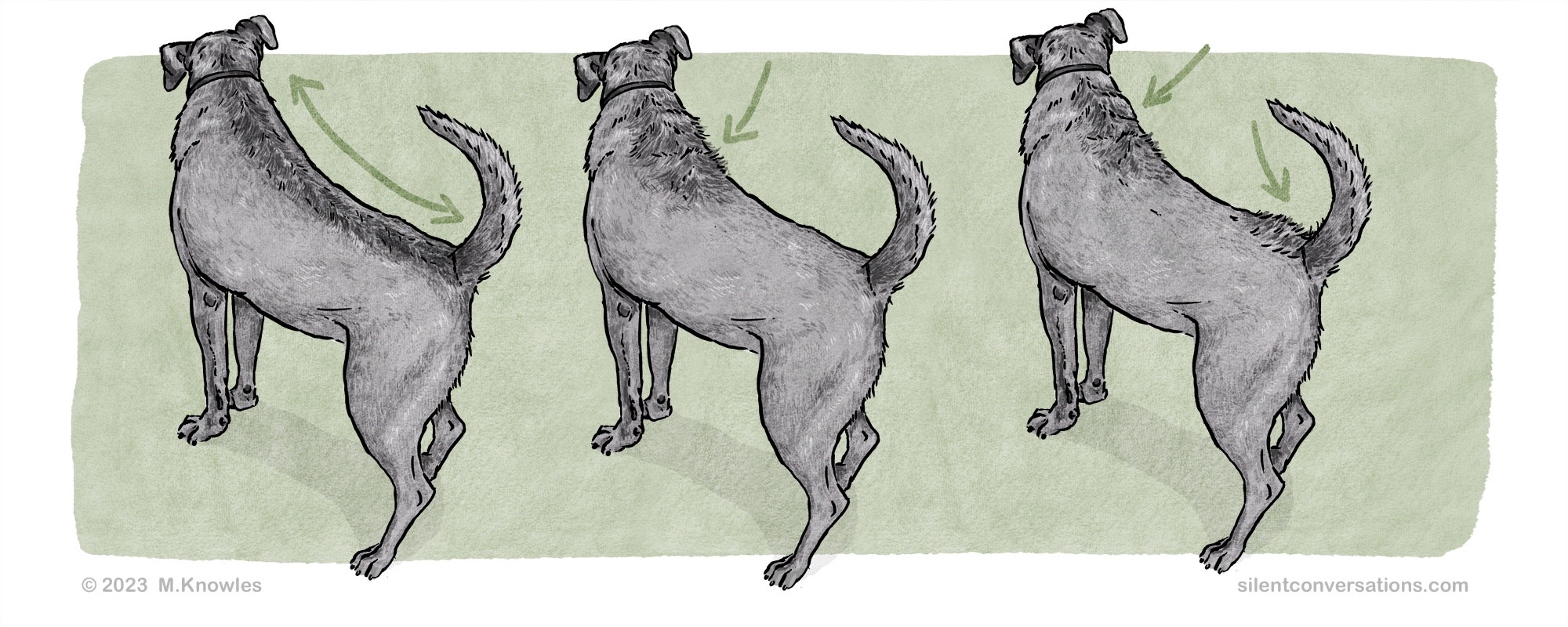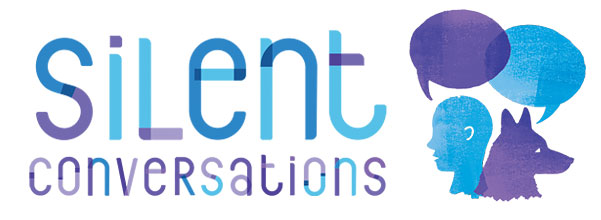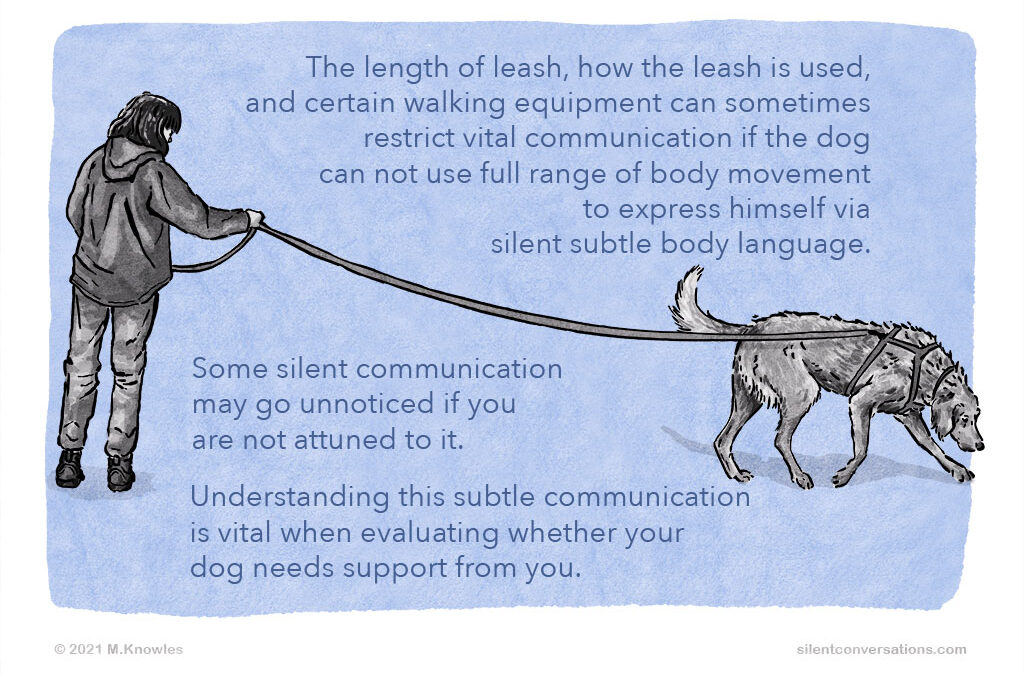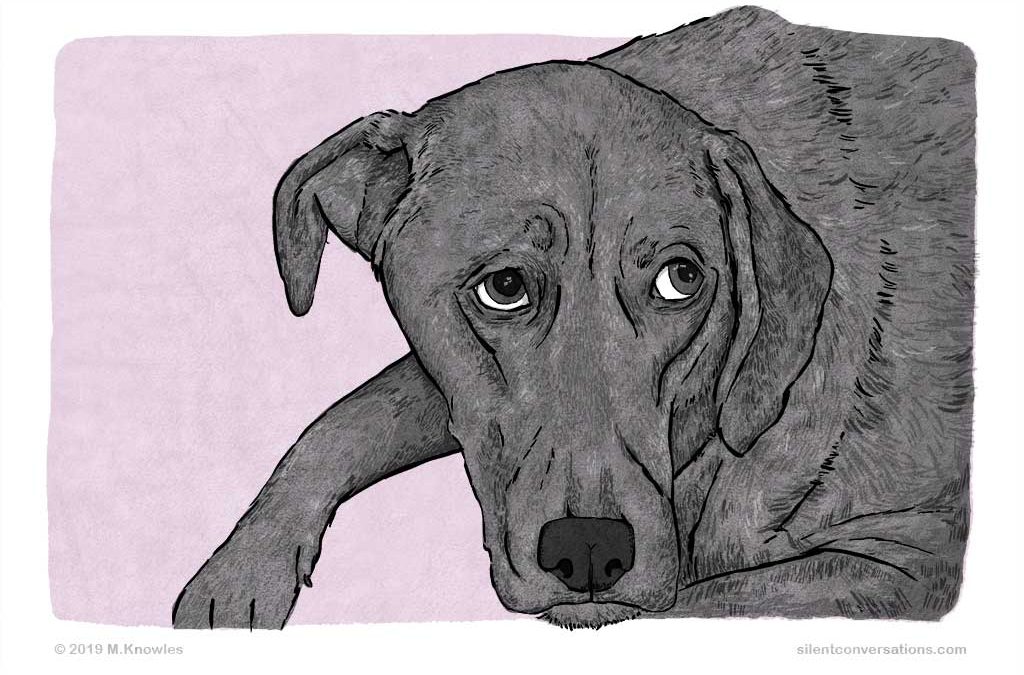
‘Raised Hackles’ or Piloerection – Dog Body Language
‘Raised Hackles’ or Piloerection – Dog Body Language
When a dog’s hair bristles up or stands on end over the spine region of the back, this is known as ‘raised hackles’ or technically defined as piloerection. The pattern area in which the hair raises can vary and display differently in each individual dog; the hair can raise fully over the spine from the neck to the base of the tail, or just over the shoulder area, or in two patches – one patch over the shoulder area and the other at the rear end, just before the base of the tail. Piloerection is commonly misinterpreted as aggression, but although it can be part of an aggressive display in certain contexts, along with specific body language exhibited, this is not the primary reason it occurs.
To determine whether it is an aggressive or antagonistic display, the piloerection is to be observed with complete body language within context before interpretation is offered, so you should view the dog from nose to tail: What is the eye shape and appearance? Where are the ears positioned? What is the posture of the dog? What is the tail position and movement? How is the dog moving? In what context is the dog displaying piloerection? What is occurring in the environment before, after and during?

There is an article, written by Karen B. London, PhD that speculates that the three different patterns in which the piloerection is displayed correlate to three different emotional behavioural categories the dog may be expressing. To categorize, you would have to observe associated body language for that category of emotion, together with the piloerection, in order to gauge whether this interpretation bears scrutiny. The author acknowledges that this is anecdotal and further study would need to be conducted. For example, I have seen the display of raised fur along the full back in differing body language displays, possibly indicating it is not consistently shown in a particular emotion and can vary with the individual. There would have to be study observing the nuances with a larger data set collected. Patricia Mc Connell also discusses the article regarding piloerection in her blog article.
To understand how piloerection can occur in differing emotions, it is worth looking at the physiology of what is happening in the body. At the base of the hair follicle there is a muscle called the Arrector pili. This small muscle contracts and is activated by the sympathetic nervous system, meaning the individual hairs raise due to an involuntary response. The sympathetic nervous system dictates ‘fight or flight’ within the autonomic nervous system, and the parasympathetic dictates ‘rest and digest’. Both sympathetic and parasympathetic parts of the autonomic system are in constant adjustment. The sympathetic system responds to neural and hormonal feedback to physiological stress. When considering physiological stress, this is not necessarily an indication of negative emotion; similar hormones may be expressed whether the emotion ranges from excitement to fear. Piloerection can therefore occur due to fear, surprise, excitement, arousal, or as part of agonistic intent or aggressive display.
Piloerection is also classified as an Epiphenomenon in Barbara Handleman’s book, ‘Canine Behaviour: A Photo Illustrated Handbook’. An Epiphenomenon [1] is a secondary phenomenon or effect that occurs along with a primary phenomenon. For instance, piloerection would occur as a secondary phenomenon along with indications of stress or arousal. An example of indicators of stress would be evident in body language such as ears held back, squinting eyes, lip licks, lowered body posture, paw-lift, tail lowered, and so on.
Here are a few examples of situations in which dogs have displayed piloerection:
- This is an observation of two dogs at a dog park. An adolescent dog runs past a couple of dogs to try initiating play though chase. His body is loose, and his tail wags loosely in wide motions, with the tail held at about the same height as his back. A larger dog decides to participate by chasing the young dog. Catching up with the adolescent dog, the large dog keeps slamming his body into him. The adolescent dog tries to continue running; if he slows or stops, he is bowled over by the large dog. The adolescent dog’s body language begins to change whilst being pursued; his tail is down, and his rear appears slightly crouched down as he runs. His ears are back, eyes wide, and mouth open. He is panting, and he seems to be scanning the environment more intently whilst running. Along with this body language, he starts to show some piloerection, with his fur standing on end over his shoulders and rear end. This interaction started as play, but as it continued, the adolescent dog was overwhelmed and seemed to have no choice but to keep running as fast as he could in order to try to escape the pursuit of the larger dog. There seemed to be no role reversal during play between the two, with the larger dog persistently slamming his body into the adolescent dog without taking any notice of the younger dog’s changed body language. After being chased and unable to escape, with no one intervening, the adolescent dog is progressively showing signs of feeling uncomfortable with this interaction.
- A dog rescue volunteer is walking a dog on a quieter route back to his kennel via a back entrance. However, this route goes past an outdoor cat enclosure. No cats are visible, as they are hiding under the foliage in the outdoor enclosure. The volunteer takes the dog in a wider curve past the enclosure. The dog starts slowing as they pass the enclosure; his body seems more rigid, while his tail is held stiffly and a little higher than the level of his back. The dog’s ears are up and pointing forward, his mouth closes, he ducks his head down, and he sniffs the ground momentarily. He is also slowly displaying piloerection along his full back. The dog continues to move slowly, then pauses slightly, with a paw lift. The volunteer encourages the dog to keep moving and they pass the cat enclosure. This is a dog that is not keen on cats. Although no cats are visible, in all likelihood the dog is picking up on the scent of the cats and is aware of their presence. The body language displayed by the dog can be interpreted as unsure and unsettled, perhaps a bit aroused, most probably by sensing the cats nearby. He seems weary of their presence via scent even though the cats are not seen.
- As a dog enters the dog park, a couple of dogs across the park start to speedily approach her. Although she is aware of the approaching dogs, she seems to be avoiding them and curves away from them, walking along the periphery of the park fence and sniffing the ground. She gives the appearance of not noticing the approaching dogs but is aware. Her head is dipped as she sniffs, but her eyes are directed ahead as she subtly eyes the environment. She continues to walk slowly and sniff the ground and shows some piloerection when one of the dogs encroaches nearer. The dog approaches quickly and very directly, walking in a straight line towards her. The approaching dog seems quite tall in posture, his ears are up and forward, his mouth is closed, and his tail is up, with the tip of the tail flagging (top of the tail shows quick back and forth movements). Together with this body language, he is also showing piloerection over his shoulder area. He moves in quite closely to her, they both pause for a moment, and she turns her head away. His movements seem jittery, and he quickly moves to her rear and attempts to sniff quite invasively. She moves away promptly, squats, pees, and walks away further. He is then redirected to sniff where she has peed, and he marks the spot. Both dogs were a bit uncomfortable with the interaction. She made it very clear she did not wish to be approached by curving away from the dog, moving away from the interaction, and peeing on the ground, giving the dog an option of sniffing without physical contact. The approaching dog, although he chose to approach, in all likelihood did not feel comfortable, as shown by his jittery movement, tall body posture, high flagging tail, and piloerection. Being in a situation where there are many unknown dogs entering the dog park, some dogs may feel the pressure to approach, even when unsure, in order to assess each dog. One of the places where I quite commonly observe piloerection is fast direct meetings between unfamiliar dogs at the entrance of the dog park.
- A dog is being walked in the park on a windy day. A plastic bag that has blown across the park has become hooked on a small bush and is rustling about in the wind. As the dog guardian and the dog approach the rustling bag, the dog slows and pauses; her body lowers and her head dips. She starts showing piloerection across her whole spine all the way to her tail. Her ears go forward and up, her tail drops and starts wagging fast, and she lets out a lone bark. With her body and head still in a lowered position, she circles around the bag. Her tail lowers as she tentatively moves a little forward, her posture weighted on her back legs, which are slightly splayed. She turns around, and again, with lowered body and head, and her tail down, curves around the bag in the other direction without venturing closer to it. The lowered body posture, with weight on the back legs, tail down, and piloerection, all demonstrate the dog is fearful and feeling unsure of this novel item that moves irregularly in the wind.
- A dog is chewing on a bone when the other dog in the household attempts to walk past him. The dog chewing the bone freezes and lowers his head slightly over the bone while trying to give direct eye contact to the other dog, causing some whale eye (where the white of the eye is visible). His eyes also appears hard. The bridge of his nose is wrinkled, and his lips are pulled back, exposing the front teeth. The commisures (corners of the mouth) are pushed forward as he lets out a growl. Along with this body language, he shows some piloerection over the shoulder area. The dog is resource guarding the bone and displays some agonistic behavior in order to warn the other dog, with the intention of creating space.
- A person is returning home with a friend. The dog barks when the door is opened and the friend enters the house. The dog’s ears are back and her head is slightly lowered. Her tail is lower and wagging fast, while her weight is being shifted towards her back legs. She retreats quickly and then moves in an arch around the guest, continuing to bark as she follows the people to the kitchen. Due to her short fur, it almost looks like she has a shadow extending all down her back to her tail. This is piloerection. In the kitchen, she seems to recognize the guest and is no longer barking. Her body is moving more loosely and fluidly, while the piloerection appears to have disappeared. She jumps up against the guest’s leg and then walks away with a wiggly body, subsequently sneezing and shaking herself off. The piloerection could have occurred partly due to the dog’s surprise at not expecting to see the guest and/or possibly due to some excitement.
These are just a few examples; there may be many more. Start observing to see if you can notice piloerection in different contexts. As discussed below, interpretations such as the above examples should not be attempted without careful observation and consideration of all aspects of the situation.
Reference:
[1] Canine Behaviour: A Photo Illustrated Handbook, by Barbara Handleman, Section is 6 (Table of Contents). For further reading, visit the resources section.
What is meant by stress?
When I mention stress, this does not necessarily imply negative emotion. I mean stress in the physiological sense. So certain body language signals can mean the dog is feeling some sort of emotional discourse. This discourse could range from positive to negative emotion. Both excitement and fear could have similar effects on the body, with various hormones being released and activating the sympathetic nervous system. The dog may be feeling uncomfortable/fearful or it could also be excited about something. When analyzing stress in body language, it is worth noting the frequency and intensity of the various body language signals.
A few notes to consider when observing dog body language:
Observation before interpretation
Interpretations should be offered only once you have observed the complete interaction and taken note of the wider picture. To offer an unbiased interpretation of the body language, observe and take note of the situation, taking into account the dog’s whole body, the body language signals, and environment first before offering an interpretation. List all the body language you see in the order that it occurs; try to be as descriptive as possible without adding any emotional language. For instance, saying a dog looks happy is not descriptive and would be seen as an interpretation rather than an observation.
You could, however, list what you observe: ears to the side, eyes almond shaped, slight shortening of the eye, mouth open, long lips, tongue out, body moving loosely, body facing side-on, tail wagging at a slow even pace at body level.
From the observation, I could interpret that the dog seems relaxed or comfortable. I still prefer to say relaxed rather than happy, as I feel you will truly never know exactly what the dog may be feeling on the inside emotionally. It is quite likely the dog may be feeling happy, but I prefer to comment on how the dog is behaving in response to the situation rather than presuming internal emotional states.
The importance of viewing body language within context
Interpretations can vary depending on the context. It is possible for certain body language to be used in different contexts and have subtle differences in meaning within those contexts. Individual body language signals should not be observed in isolation; the wider picture should be considered. Take note of what the dog’s body as a whole is saying. Keep in mind each dog is an individual with varying skills and experiences. What may be typical for one individual may not be for another. In order to observe body language in context, consider the following: the situation, body language signals, the body language expressed by all parts of the dog’s body, environment, and individuals involved. It is worth noting how the body language changes with feedback from the environment or the other individuals interacting.

Martha Knowles
Author
My vision is to create a community of dog guardians who share their observations and interpretations of their dogs’ silent conversations. Hopefully, these experiences and stories will provide some insight into dog communication, which is often overlooked by the untrained eye because it is unfamiliar to humans. We are accustomed to communicating mainly with sound, so we are not attuned to the silent subtle gestures and body language used by dogs to communicate. If you take the time to observe, you will start to see these 'silent conversations' going on around you. My dream is for dog communication to become common knowledge with all dog guardians and as many people as possible. Surprisingly, there are still some professionals working in various dog-related careers who are uneducated about dog body language. Greater awareness of how dogs communicate will help to provide better understanding and improve the mutual relationship between dogs and humans. This will promote safer interactions between our two species and hopefully remove some of the expectations placed on dogs within human society. I would like dog guardians to feel empowered with their knowledge of dog communication so that they can be their dogs’ advocates and stand up for themselves and their dogs when it really matters.




